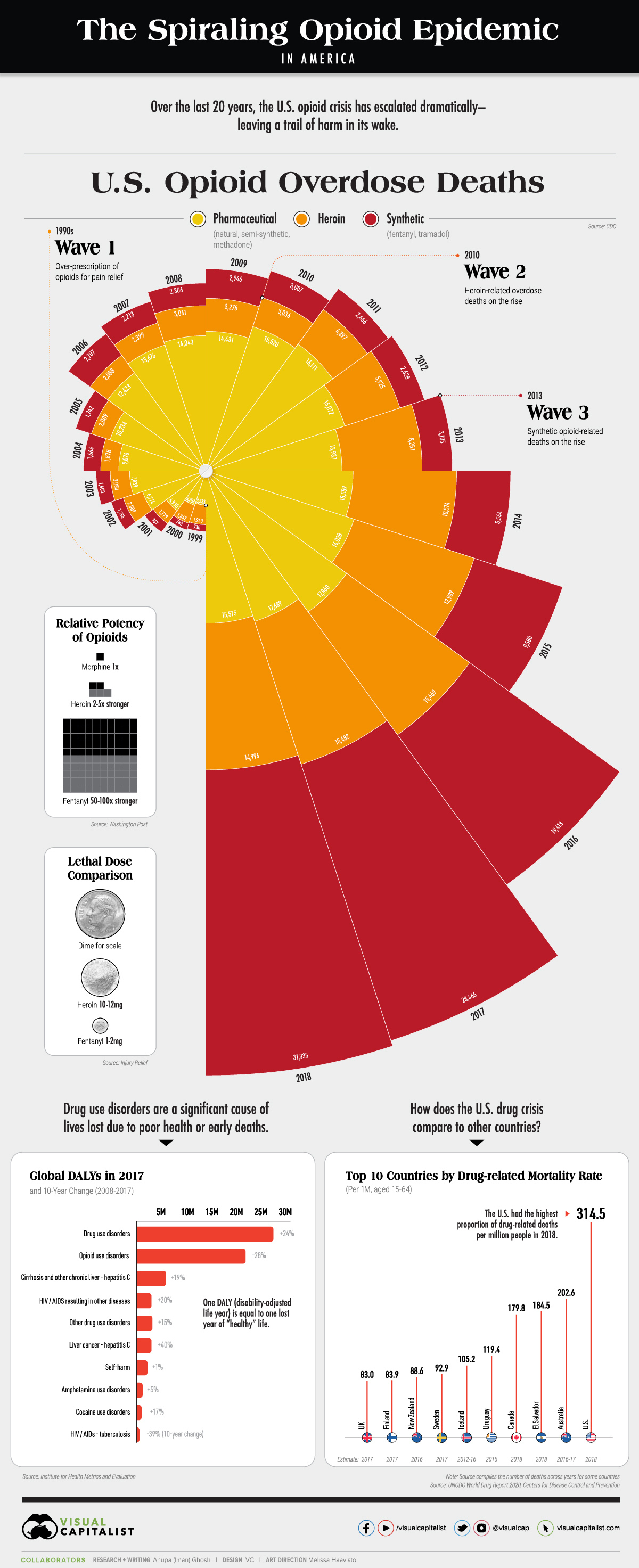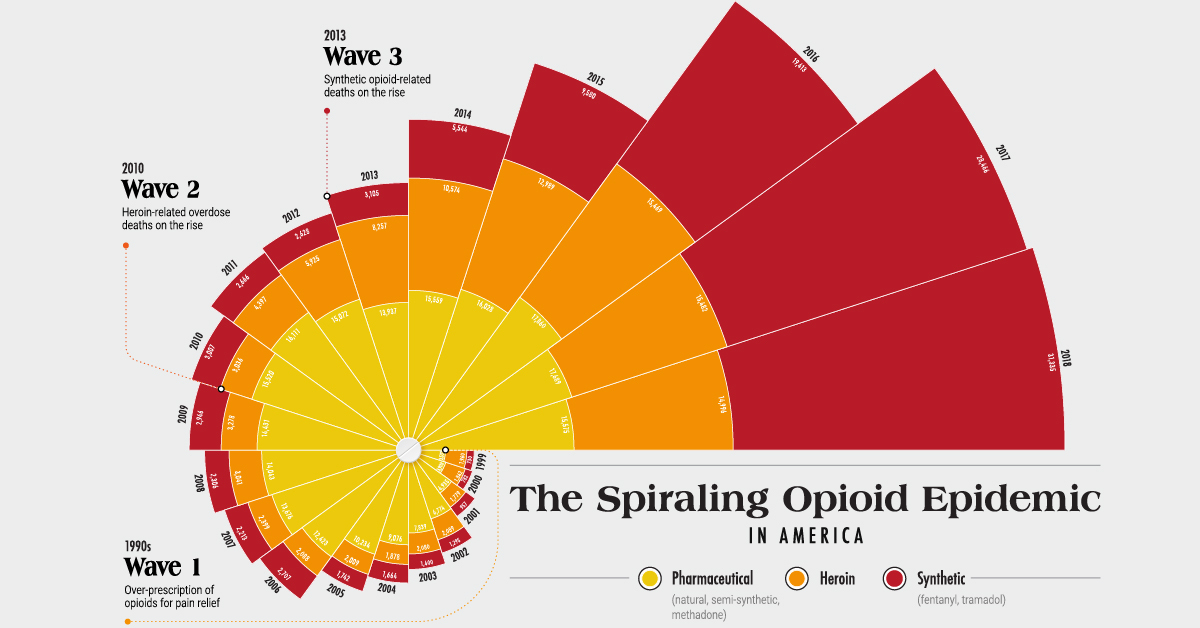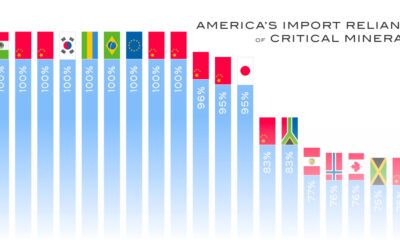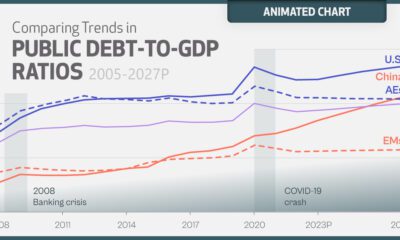Misc
The Spiraling Opioid Epidemic in America

The Spiraling Opioid Epidemic in America
Over the last 20 years, the ongoing U.S. opioid crisis has claimed tens of thousands of lives. In fact, opioid overdose deaths accounted for nearly 70% of all drug overdose deaths in 2018.
Although the damage of the opioid epidemic is well documented, what people might not know is that it has escalated in three distinct waves.
We pull the latest statistics from the UN World Drug Report 2020 to uncover the scope of the opioid crisis in the U.S., and how national drug-related death rates compare to other countries.
Three Waves of the Opioid Crisis
According to the CDC, the opioid epidemic can be traced back to the 1990s, when opioids started being over-prescribed for pain relief purposes.
- 1990s – Wave 1
Over-prescription of opioids for pain relief, including natural opioids, semi-synthetic opioids, and methadone. Addiction risks were widely downplayed. - 2010 – Wave 2
Heroin-related overdose deaths on the rise. - 2013 – Wave 3
Synthetic opioid-related deaths on the rise, particularly fentanyl and tramadol.
Here’s how that breaks down in terms of opioid-related overdose deaths over the years. Note that by the year 2018, 67% of overdose deaths involved synthetic opioids such as fentanyl.
| Year | Any opioids | Heroin | Pharmaceutical opioids | Synthetic opioids |
|---|---|---|---|---|
| 1999 | 8,050 | 1,960 | 3,533 | 730 |
| 2000 | 8,407 | 1,842 | 3,903 | 782 |
| 2001 | 9,496 | 1,779 | 4,935 | 957 |
| 2002 | 11,920 | 2,089 | 6,774 | 1,295 |
| 2003 | 12,940 | 2,080 | 7,839 | 1,400 |
| 2004 | 13,756 | 1,878 | 9,076 | 1,664 |
| 2005 | 14,918 | 2,009 | 10,234 | 1,742 |
| 2006 | 17,545 | 2,088 | 12,423 | 2,707 |
| 2007 | 18,516 | 2,399 | 13,676 | 2,213 |
| 2008 | 19,582 | 3,041 | 14,043 | 2,306 |
| 2009 | 20,422 | 3,278 | 14,431 | 2,946 |
| 2010 | 21,089 | 3,036 | 15,520 | 3,007 |
| 2011 | 22,784 | 4,397 | 16,111 | 2,666 |
| 2012 | 23,166 | 5,925 | 15,072 | 2,628 |
| 2013 | 25,052 | 8,257 | 13,937 | 3,105 |
| 2014 | 28,647 | 10,574 | 15,559 | 5,544 |
| 2015 | 33,091 | 12,989 | 16,028 | 9,580 |
| 2016 | 42,249 | 15,469 | 17,860 | 19,413 |
| 2017 | 47,600 | 15,482 | 17,689 | 28,466 |
| 2018 | 46,802 | 14,996 | 15,575 | 31,335 |
Overdose deaths from synthetic opioids such as fentanyl and tramadol shot up by over 4,000% between 1999-2018. This can be attributed to two things: their relative potency, and the minute quantities of each that qualify as a lethal dose.
As per the medical and legal standard, opioids are often compared to morphine. To that end, heroin is 2-5x stronger—while fentanyl is 50-100x more potent. Put another way, roughly a dime-size or 10-12mg of heroin is considered a lethal dose, compared to only 1-2mg of fentanyl.
What’s worse, fentanyl is typically mixed with other types of drugs such as heroin or cocaine to increase their effects, which is how it ends up unintentionally ingested. Between 2008-2017, drug-use disorders as a whole claimed the most healthy lives due to poor health or early deaths—measured in disability-adjusted life years (DALYs)—followed in close second by opioid use disorders.
The Death Toll of U.S. Drug Overdoses
It’s undeniable that the opioid epidemic in America has caused significant harm to communities. But how does the U.S. drug crisis compare to the same issue in other countries?
The UN Drug Report further puts these numbers into perspective by comparing drug-related deaths per million population. Note that the source also compiled the total deaths across years for selected countries.
| Country (Latest Year) | Latest Years of Estimate | Total Deaths | Rate per 1M (Aged 15-64) |
|---|---|---|---|
| 🇺🇸 U.S. | 2018 | 67,367 | 314.5 |
| 🇦🇺 Australia | 2016-2017 | 3,240 | 202.6 |
| 🇸🇻 El Salvador | 2018 | 765 | 184.5 |
| 🇨🇦 Canada | 2018 | 4,460 | 179.8 |
| 🇺🇾 Uruguay | 2016 | 264 | 119.4 |
| 🇮🇸 Iceland | 2012-2016 | 23 | 105.2 |
| 🇸🇪 Sweden | 2017 | 575 | 92.9 |
| 🇳🇿 New Zealand | 2016 | 269 | 88.6 |
| 🇫🇮 Finland | 2017 | 289 | 83.9 |
| 🇬🇧 UK | 2017 | 3,547 | 83 |
With 314.5 deaths per million, the U.S. by far had the highest proportion of drug-related deaths per million people in 2018. It also had the highest overall number at 67.4K deaths.
Elephant in the Room?
Another drug rearing its head on the streets is carfentanil. Formerly developed as ‘elephant tranquilizer’, this synthetic opioid is similar in appearance to other illicit drugs such as heroin, making it indistinguishable when mixed in. However, there’s one big problem—carfentanil is 100x more potent than fentanyl itself.
In response to the continued crisis, an additional $35.7 billion was requested for counter-drug funding efforts in the FY2021 Budget. This amount is expected to go towards prevention and treatment efforts ($18.6 billion) and law enforcement efforts ($17.1 billion) both domestically and internationally.
But will these efforts properly combat the crisis, or are we already in the midst of a fourth wave of the opioid epidemic?
VC+
VC+: Get Our Key Takeaways From the IMF’s World Economic Outlook
A sneak preview of the exclusive VC+ Special Dispatch—your shortcut to understanding IMF’s World Economic Outlook report.

Have you read IMF’s latest World Economic Outlook yet? At a daunting 202 pages, we don’t blame you if it’s still on your to-do list.
But don’t worry, you don’t need to read the whole April release, because we’ve already done the hard work for you.
To save you time and effort, the Visual Capitalist team has compiled a visual analysis of everything you need to know from the report—and our upcoming VC+ Special Dispatch will be available exclusively to VC+ members on Thursday, April 25th.
If you’re not already subscribed to VC+, make sure you sign up now to receive the full analysis of the IMF report, and more (we release similar deep dives every week).
For now, here’s what VC+ members can expect to receive.
Your Shortcut to Understanding IMF’s World Economic Outlook
With long and short-term growth prospects declining for many countries around the world, this Special Dispatch offers a visual analysis of the key figures and takeaways from the IMF’s report including:
- The global decline in economic growth forecasts
- Real GDP growth and inflation forecasts for major nations in 2024
- When interest rate cuts will happen and interest rate forecasts
- How debt-to-GDP ratios have changed since 2000
- And much more!
Get the Full Breakdown in the Next VC+ Special Dispatch
VC+ members will receive the full Special Dispatch on Thursday, April 25th.
Make sure you join VC+ now to receive exclusive charts and the full analysis of key takeaways from IMF’s World Economic Outlook.
Don’t miss out. Become a VC+ member today.
What You Get When You Become a VC+ Member
VC+ is Visual Capitalist’s premium subscription. As a member, you’ll get the following:
- Special Dispatches: Deep dive visual briefings on crucial reports and global trends
- Markets This Month: A snappy summary of the state of the markets and what to look out for
- The Trendline: Weekly curation of the best visualizations from across the globe
- Global Forecast Series: Our flagship annual report that covers everything you need to know related to the economy, markets, geopolitics, and the latest tech trends
- VC+ Archive: Hundreds of previously released VC+ briefings and reports that you’ve been missing out on, all in one dedicated hub
You can get all of the above, and more, by joining VC+ today.
-

 Green1 week ago
Green1 week agoRanked: The Countries With the Most Air Pollution in 2023
-

 Automotive2 weeks ago
Automotive2 weeks agoAlmost Every EV Stock is Down After Q1 2024
-

 AI2 weeks ago
AI2 weeks agoThe Stock Performance of U.S. Chipmakers So Far in 2024
-

 Markets2 weeks ago
Markets2 weeks agoCharted: Big Four Market Share by S&P 500 Audits
-

 Real Estate2 weeks ago
Real Estate2 weeks agoRanked: The Most Valuable Housing Markets in America
-

 Money2 weeks ago
Money2 weeks agoWhich States Have the Highest Minimum Wage in America?
-

 AI2 weeks ago
AI2 weeks agoRanked: Semiconductor Companies by Industry Revenue Share
-

 Travel2 weeks ago
Travel2 weeks agoRanked: The World’s Top Flight Routes, by Revenue


















